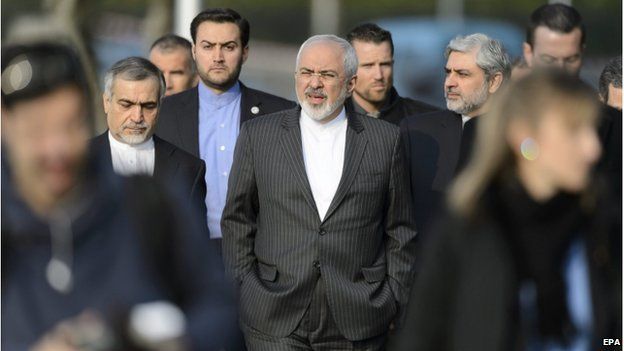Are the Iran nuclear talks heading for a deal?
-
Published

Winter into Spring: it's a powerful symbol at the nuclear talks in Lausanne, on the shore of Lake Geneva.
The Iranian and American delegations are acutely aware this weekend brings one of the most important festivals in the ancient Persian calendar - Norouz or New Year.
It now looks as if the Iranians will be back home in Tehran in time to exchange gifts with family and friends, but not yet carrying with them a huge political gift - an outline plan to limit their nuclear programme in exchange for the relaxation of international sanctions.
Instead, Iran's foreign minister and his team have set up their own traditional Norouz table - the Haft Seen - in one of the splendid rooms of the 19th Century Beau-Rivage Palace Hotel.
Such tables are usually decorated with at least seven ancient symbols derived from Zoroastrianism.
So you could expect to find something growing - perhaps wheat or barley - representing rebirth, as well as a sweet pudding which symbolises affluence, and other pointers to health, patience, love.
Respect and dignity
All this matters because symbolism plays a very large part in the talks process too.
From an Iranian point of view, it is vital that respect and dignity be shown to them, their nation and historic greatness, in return for what they see as an act of self-denial.
From their point of view, that self-denial would be part of any agreement to give up parts of what they see as their legal right to a nuclear programme which they insist is entirely civil and non-military.
The other side in these talks, the five world powers who have vetoes on the UN Security Council plus Germany, see things very differently.
They need an agreement they believe places sufficient verifiable limits on Iran's nuclear scientists and their equipment so that even if the country broke the deal and made a dash for the "bomb" the rest of the world would have enough time to react.
So these talks exist on several different planes.
Some days, it's the nuclear eggheads from both sides who sit down together to pick over the deep detail of Iran's capacity:
- numbers of centrifuges for the enrichment of uranium,
- the transparency or otherwise of its nuclear sites across the country,
- the ways in which inspectors from the International Atomic Energy Agency can be given real confidence it would be all but impossible to deceive them in future.
On the US side, that means one of the officials who is here has vast knowledge and experience of the technical detail.
He is Kevin Veal, a nuclear physicist, who has worked for 11 years at Los Alamos, and was part of nuclear negotiations with North Korea.
According to the US administration, he has travelled 10 times to North Korea, and has spent a total of five months in that most secretive nuclear state.
Mr Veal is one of those who will need to be persuaded the deep detail of any eventual agreement is robust enough for him to commend it to his political masters.
It doesn't look as if he is there yet, but there is still time, as a first outline political plan can be agreed with space left for a few more weeks work on the absolutely vital technical detail.
Political battle
But it is the political talks which will ultimately determine success or failure reaching agreement with Iran by the end of June.
One remarkable aspect of that political dialogue is simply the amount of time the American and Iranian Foreign ministers have now spent together.
John Kerry and Javad Zarif are clearly able to work together.
The body language when they allow the cameras in for what the Americans call a "spray" at the beginning of many of their sessions together strongly suggests that.
At least one reporter has called these talks "tense".
To me, that is not how it looks.
The atmosphere feels positive, even if success is still far from guaranteed.
The climate for talks matters a great deal, particularly when such huge issues are at stake.
Any eventual agreement would be of huge historic importance, opening a huge, heavy door.
It could lead to an entirely new relationship between Iran and the outside world in general, and the US in particular.
Suspicions remain
Many people, in both countries, remain intensely suspicious of the other.
Barack Obama, who has staked a lot on a breakthrough success he clearly believes would form a substantial positive legacy of his presidency, is once again championing hope.
In the four-minute video message to the Iranian people he recorded to mark Norouz, the president describes how he and Michelle Obama have "even created our own Haft Seen, representing our hopes for the new year".
"This year, we have the best opportunity in decades to pursue a different future between our countries."
But Iran's apparent response seems more guarded.
Foreign Minister Javad Zarif has told John Kerry that, in Farsi, Norouz means "new day".
"I hope this new day will be a new day for the entire world - a new era of greater understanding and peace."
But Mr Zarif has also tweeted that it is "high time for the US and its allies to choose" between "pressure or agreement".
Winter in relations with Iran has not yet turned to spring.
-
-
Published25 November 2014
-
-
-
Published14 July 2015
-